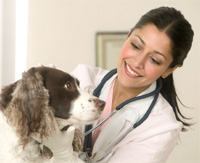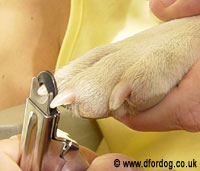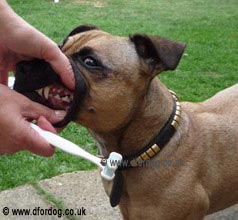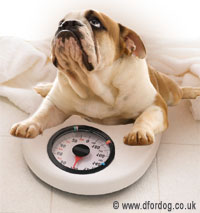Home Dog Health Check
For any breed of dog, regardless of coat type, a weekly groom can have many benefits not only to the dog's skin and coat but also to your relationship. Weekly grooming can be a great bonding exercise.

The grooming session is an excellent time to check on other aspects of your dog's health. During your home health check you may spot issues that might otherwise be missed.
Coat
Regular brushing, no matter what coat length, can help promote healthy coat and skin and good circulation. As you groom, deal gently with any mats or caught objects and check for parasites such as fleas or ticks. Dogs that run in long grass or forest areas should be regularly checked for ticks after each walk. See The Best Way to Remove a Dog Tick for more information on safe dog tick removal.
As you groom, check the condition of your dog's skin and coat. A dull greasy coat, flaky dandruff, pink skin, sores, lumps and so on can all indicate health problems. Older dogs in particular can develop lumps that are simply fatty deposits but it is always best to monitor them and get them checked by a vet.
Feet

With long haired dogs check that the feet are kept trimmed and that no mats have built up in this area. Mats or items such as grass seeds caught between pads can cause discomfort.
It is important to pay attention to your dog's nails, pads and between the pads. Many dogs move on enough hard surfaces for their nails to naturally be kept at a good length, but if your dog only exercises on soft ground, is old or for any other reason your dog's nails may not get naturally filed down, you will need to get them used to having their nails cut.
For more information on nail cutting and care please see our article on When and How to Cut Your Dog's Nails.
Ears
Your dog's ears should be clean and odour free with no inflammation or discharge. Long haired dogs may need long ear hair regularly trimming. Ear mites are a fairly common parasite of dogs. A dark granulated discharge in the ears can indicate ear mites. Also check for wax and general cleanliness of the ear. If necessary, clean the ears carefully with special ear cleaning solutions. Never put anything into your dog's ear or ear canal such as human cotton buds. If they are not designed for dogs they can seriously damage the ear structures.
Mouth

Checking your dog's teeth, breath and gums is important. Bad dog breath can be a sign of tooth decay, gum disease or intestinal problems. Unpleasant dog breath is not to be expected and should always be investigated further. When checking gums, they should be pale pink and the colour should return when gently pressed. Check for inflammation, odour, or any redness.
Teeth should be inspected for general condition, looking in particular for any broken teeth and plaque build-up. A frighteningly high percentage of pets are in urgent need of dental treatment. This means that they are walking around with infection and inflammation in their mouths which can spread to affect the whole body including the heart, kidneys and liver. It is important to remember that most dental disease is treatable and certainly the vast majority of dental disease is preventable. For more information please read How To Clean A Dog's Teeth, which includes information on teeth cleaning and care.
Eyes
Your dog's eyes should look clear and bright with no discharge or inflammation. As your dog gets older, check for cataracts, which is a very common eye complaint in older age. Cataracts shows as a cloudy lens. As dogs age they all develop a hardening of the lens that causes the lens to have a greyish appearance. This is not a cataract, and does not usually interfere with vision. However, a cataract will interfere with vision, from blurring to complete vision loss. Cataracts can in fact occur at any age so if you see any cloudiness, ask your vet to make further checks.
Weight

Millions of UK dogs are obese. Obesity is thought to be a serious problem for over a third of the UK's combined cat and dog population.
It is vitally important that you keep your dog at a sensible weight. Obesity puts strain on the joints which, combined with reduced exercise, can lead to arthritis. Overweight dogs can also experience stress on internal organs and body structures, they can be at risk if undergoing surgery, are at increased risk of suffering from diabetes, heart and kidney problems, heat intolerance, and have a reduced life expectancy.
Genetics, age, appetite, activity level, reproductive status and the gender of a dog can influence how likely they are to become obese. As these are changing factors, checking weight is therefore an important part of your dog's health check. Run your hands along your dog's body. Ideally the ribs can just be felt with no excess fat covering them, the tummy should look tucked up when viewed from the side and the waist should narrow after the ribs (best viewed from above). For more information please read Dog Weight and Dog Obesity.
Bottom
The dog's bottom and sexual organs should be clean and odour free. There should be no discharge. Any long bottom hair should be regularly cut short so that particles do not get caught around the anus area.
If your dog regularly has problems with anal glands, often seen by bothering or dragging the bottom accompanied by a fishy odour, speak to your vet about manual evacuation of the anal glands. You can also learn to do this at home if you prefer and if your vet agrees that it should be done regularly. Please see When and How to Empty Your Dog's Anal Glands.
Regular inspection of your dog's poop can give you some very valuable information about your dog's health and whether their current diet suits them. A good stool should be firm, moist and consistent, with regular bumps.
By Jenny Prevel
© D for Dog www.dfordog.co.uk
This article belongs strictly to D for Dog and we do not authorise the copying of all or any part of it.
